Critical Analysis of a Quantitative Research Article on Drinking
VerifiedAdded on 2020/10/22
|6
|1711
|330
Report
AI Summary
This report provides a critical evaluation of a quantitative research article titled "Social anxiety and heavy situational drinking: Coping and conformity motives as multiple mediators." The assignment analyzes the research design, which is cross-sectional, assessing its strengths (quick, cost-effective) and weaknesses (difficulty in assessing cause and effect). The study's aims and objectives, sampling method (random undergraduate psychology students), sample size, and inclusion/exclusion criteria are examined. The report also evaluates the response rate, reliability, and internal consistency of the study, as well as the presentation of results and the main conclusions. The evaluation highlights the use of descriptive techniques, sample random techniques, and the overall conclusion that the researcher used reliable and internal consistency tools to gather effective information and draw conclusions.

RESEARCH METHOD IN
HEALTH AND SOCIAL CARE
HEALTH AND SOCIAL CARE
Paraphrase This Document
Need a fresh take? Get an instant paraphrase of this document with our AI Paraphraser
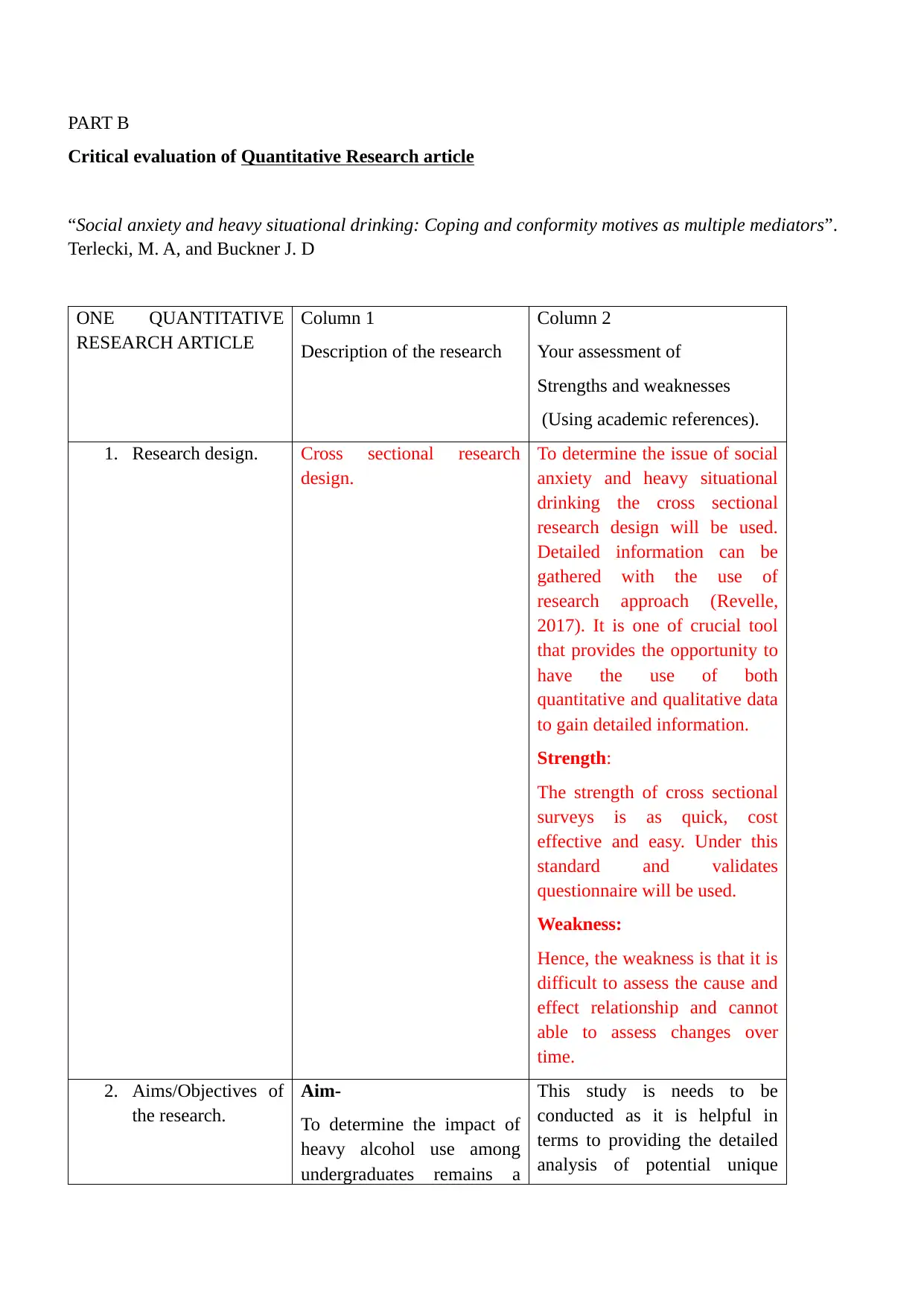
PART B
Critical evaluation of Quantitative Research article
“Social anxiety and heavy situational drinking: Coping and conformity motives as multiple mediators”.
Terlecki, M. A, and Buckner J. D
ONE QUANTITATIVE
RESEARCH ARTICLE
Column 1
Description of the research
Column 2
Your assessment of
Strengths and weaknesses
(Using academic references).
1. Research design. Cross sectional research
design.
To determine the issue of social
anxiety and heavy situational
drinking the cross sectional
research design will be used.
Detailed information can be
gathered with the use of
research approach (Revelle,
2017). It is one of crucial tool
that provides the opportunity to
have the use of both
quantitative and qualitative data
to gain detailed information.
Strength:
The strength of cross sectional
surveys is as quick, cost
effective and easy. Under this
standard and validates
questionnaire will be used.
Weakness:
Hence, the weakness is that it is
difficult to assess the cause and
effect relationship and cannot
able to assess changes over
time.
2. Aims/Objectives of
the research.
Aim-
To determine the impact of
heavy alcohol use among
undergraduates remains a
This study is needs to be
conducted as it is helpful in
terms to providing the detailed
analysis of potential unique
Critical evaluation of Quantitative Research article
“Social anxiety and heavy situational drinking: Coping and conformity motives as multiple mediators”.
Terlecki, M. A, and Buckner J. D
ONE QUANTITATIVE
RESEARCH ARTICLE
Column 1
Description of the research
Column 2
Your assessment of
Strengths and weaknesses
(Using academic references).
1. Research design. Cross sectional research
design.
To determine the issue of social
anxiety and heavy situational
drinking the cross sectional
research design will be used.
Detailed information can be
gathered with the use of
research approach (Revelle,
2017). It is one of crucial tool
that provides the opportunity to
have the use of both
quantitative and qualitative data
to gain detailed information.
Strength:
The strength of cross sectional
surveys is as quick, cost
effective and easy. Under this
standard and validates
questionnaire will be used.
Weakness:
Hence, the weakness is that it is
difficult to assess the cause and
effect relationship and cannot
able to assess changes over
time.
2. Aims/Objectives of
the research.
Aim-
To determine the impact of
heavy alcohol use among
undergraduates remains a
This study is needs to be
conducted as it is helpful in
terms to providing the detailed
analysis of potential unique
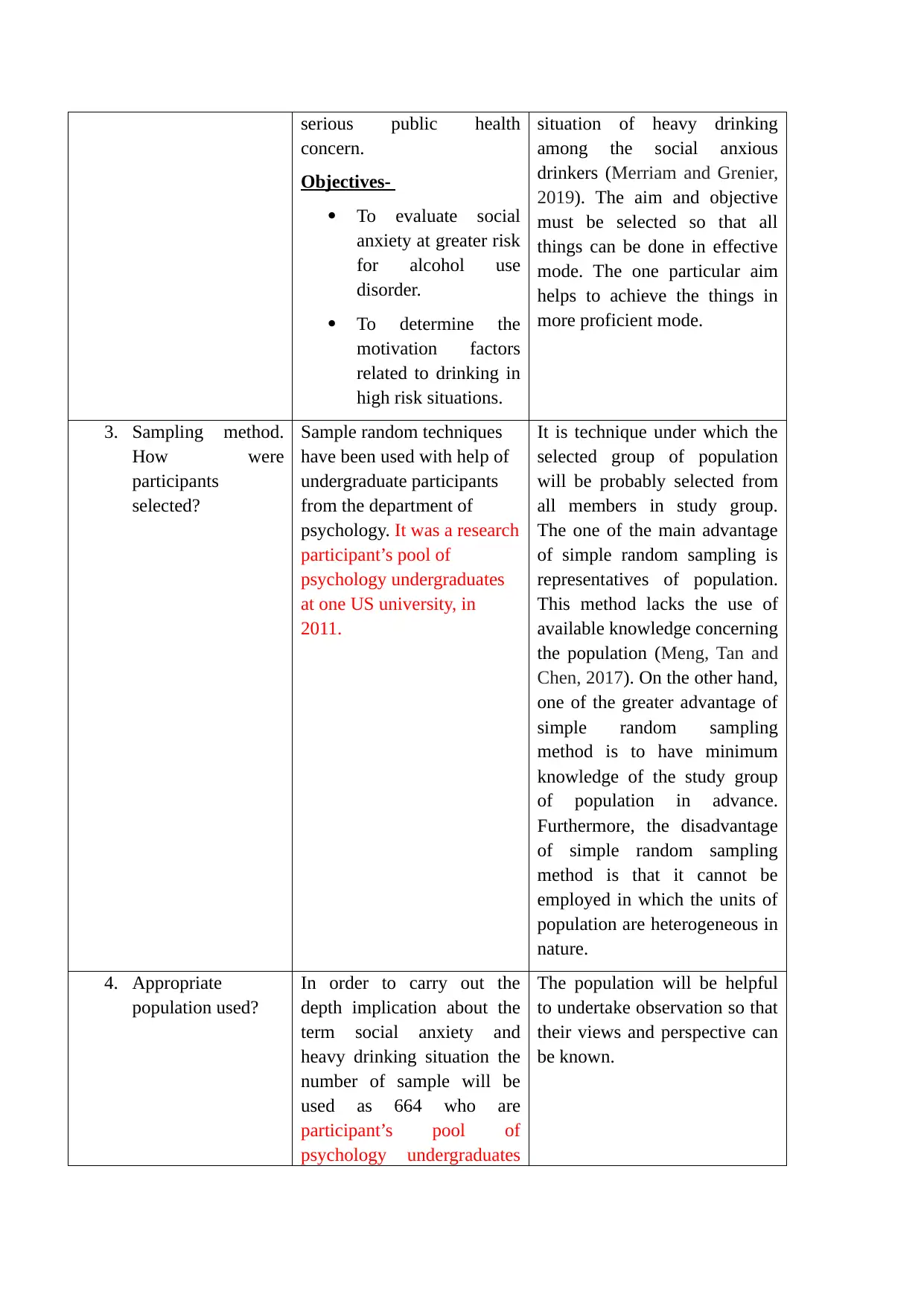
serious public health
concern.
Objectives-
To evaluate social
anxiety at greater risk
for alcohol use
disorder.
To determine the
motivation factors
related to drinking in
high risk situations.
situation of heavy drinking
among the social anxious
drinkers (Merriam and Grenier,
2019). The aim and objective
must be selected so that all
things can be done in effective
mode. The one particular aim
helps to achieve the things in
more proficient mode.
3. Sampling method.
How were
participants
selected?
Sample random techniques
have been used with help of
undergraduate participants
from the department of
psychology. It was a research
participant’s pool of
psychology undergraduates
at one US university, in
2011.
It is technique under which the
selected group of population
will be probably selected from
all members in study group.
The one of the main advantage
of simple random sampling is
representatives of population.
This method lacks the use of
available knowledge concerning
the population (Meng, Tan and
Chen, 2017). On the other hand,
one of the greater advantage of
simple random sampling
method is to have minimum
knowledge of the study group
of population in advance.
Furthermore, the disadvantage
of simple random sampling
method is that it cannot be
employed in which the units of
population are heterogeneous in
nature.
4. Appropriate
population used?
In order to carry out the
depth implication about the
term social anxiety and
heavy drinking situation the
number of sample will be
used as 664 who are
participant’s pool of
psychology undergraduates
The population will be helpful
to undertake observation so that
their views and perspective can
be known.
concern.
Objectives-
To evaluate social
anxiety at greater risk
for alcohol use
disorder.
To determine the
motivation factors
related to drinking in
high risk situations.
situation of heavy drinking
among the social anxious
drinkers (Merriam and Grenier,
2019). The aim and objective
must be selected so that all
things can be done in effective
mode. The one particular aim
helps to achieve the things in
more proficient mode.
3. Sampling method.
How were
participants
selected?
Sample random techniques
have been used with help of
undergraduate participants
from the department of
psychology. It was a research
participant’s pool of
psychology undergraduates
at one US university, in
2011.
It is technique under which the
selected group of population
will be probably selected from
all members in study group.
The one of the main advantage
of simple random sampling is
representatives of population.
This method lacks the use of
available knowledge concerning
the population (Meng, Tan and
Chen, 2017). On the other hand,
one of the greater advantage of
simple random sampling
method is to have minimum
knowledge of the study group
of population in advance.
Furthermore, the disadvantage
of simple random sampling
method is that it cannot be
employed in which the units of
population are heterogeneous in
nature.
4. Appropriate
population used?
In order to carry out the
depth implication about the
term social anxiety and
heavy drinking situation the
number of sample will be
used as 664 who are
participant’s pool of
psychology undergraduates
The population will be helpful
to undertake observation so that
their views and perspective can
be known.
⊘ This is a preview!⊘
Do you want full access?
Subscribe today to unlock all pages.

Trusted by 1+ million students worldwide
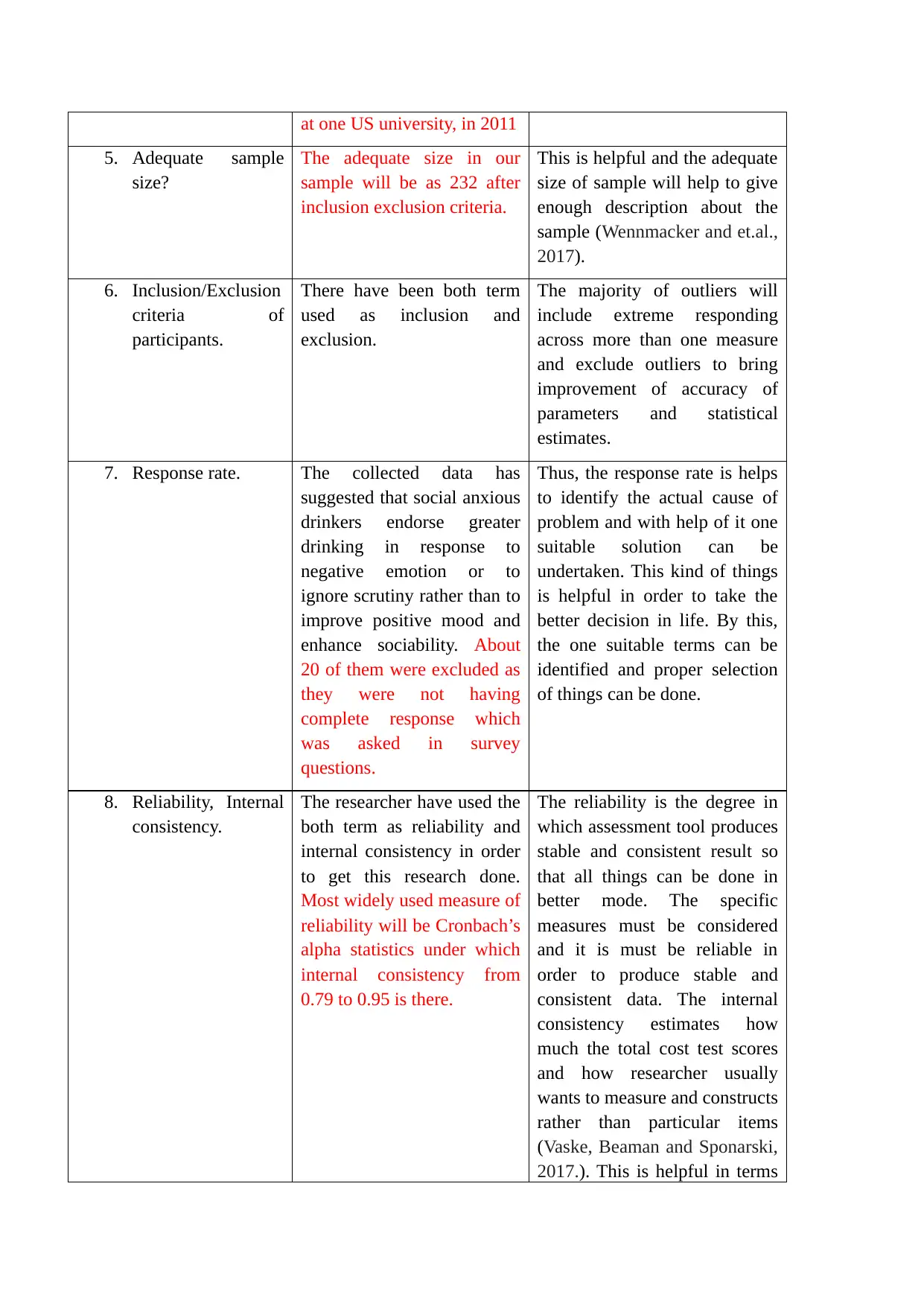
at one US university, in 2011
5. Adequate sample
size?
The adequate size in our
sample will be as 232 after
inclusion exclusion criteria.
This is helpful and the adequate
size of sample will help to give
enough description about the
sample (Wennmacker and et.al.,
2017).
6. Inclusion/Exclusion
criteria of
participants.
There have been both term
used as inclusion and
exclusion.
The majority of outliers will
include extreme responding
across more than one measure
and exclude outliers to bring
improvement of accuracy of
parameters and statistical
estimates.
7. Response rate. The collected data has
suggested that social anxious
drinkers endorse greater
drinking in response to
negative emotion or to
ignore scrutiny rather than to
improve positive mood and
enhance sociability. About
20 of them were excluded as
they were not having
complete response which
was asked in survey
questions.
Thus, the response rate is helps
to identify the actual cause of
problem and with help of it one
suitable solution can be
undertaken. This kind of things
is helpful in order to take the
better decision in life. By this,
the one suitable terms can be
identified and proper selection
of things can be done.
8. Reliability, Internal
consistency.
The researcher have used the
both term as reliability and
internal consistency in order
to get this research done.
Most widely used measure of
reliability will be Cronbach’s
alpha statistics under which
internal consistency from
0.79 to 0.95 is there.
The reliability is the degree in
which assessment tool produces
stable and consistent result so
that all things can be done in
better mode. The specific
measures must be considered
and it is must be reliable in
order to produce stable and
consistent data. The internal
consistency estimates how
much the total cost test scores
and how researcher usually
wants to measure and constructs
rather than particular items
(Vaske, Beaman and Sponarski,
2017.). This is helpful in terms
5. Adequate sample
size?
The adequate size in our
sample will be as 232 after
inclusion exclusion criteria.
This is helpful and the adequate
size of sample will help to give
enough description about the
sample (Wennmacker and et.al.,
2017).
6. Inclusion/Exclusion
criteria of
participants.
There have been both term
used as inclusion and
exclusion.
The majority of outliers will
include extreme responding
across more than one measure
and exclude outliers to bring
improvement of accuracy of
parameters and statistical
estimates.
7. Response rate. The collected data has
suggested that social anxious
drinkers endorse greater
drinking in response to
negative emotion or to
ignore scrutiny rather than to
improve positive mood and
enhance sociability. About
20 of them were excluded as
they were not having
complete response which
was asked in survey
questions.
Thus, the response rate is helps
to identify the actual cause of
problem and with help of it one
suitable solution can be
undertaken. This kind of things
is helpful in order to take the
better decision in life. By this,
the one suitable terms can be
identified and proper selection
of things can be done.
8. Reliability, Internal
consistency.
The researcher have used the
both term as reliability and
internal consistency in order
to get this research done.
Most widely used measure of
reliability will be Cronbach’s
alpha statistics under which
internal consistency from
0.79 to 0.95 is there.
The reliability is the degree in
which assessment tool produces
stable and consistent result so
that all things can be done in
better mode. The specific
measures must be considered
and it is must be reliable in
order to produce stable and
consistent data. The internal
consistency estimates how
much the total cost test scores
and how researcher usually
wants to measure and constructs
rather than particular items
(Vaske, Beaman and Sponarski,
2017.). This is helpful in terms
Paraphrase This Document
Need a fresh take? Get an instant paraphrase of this document with our AI Paraphraser
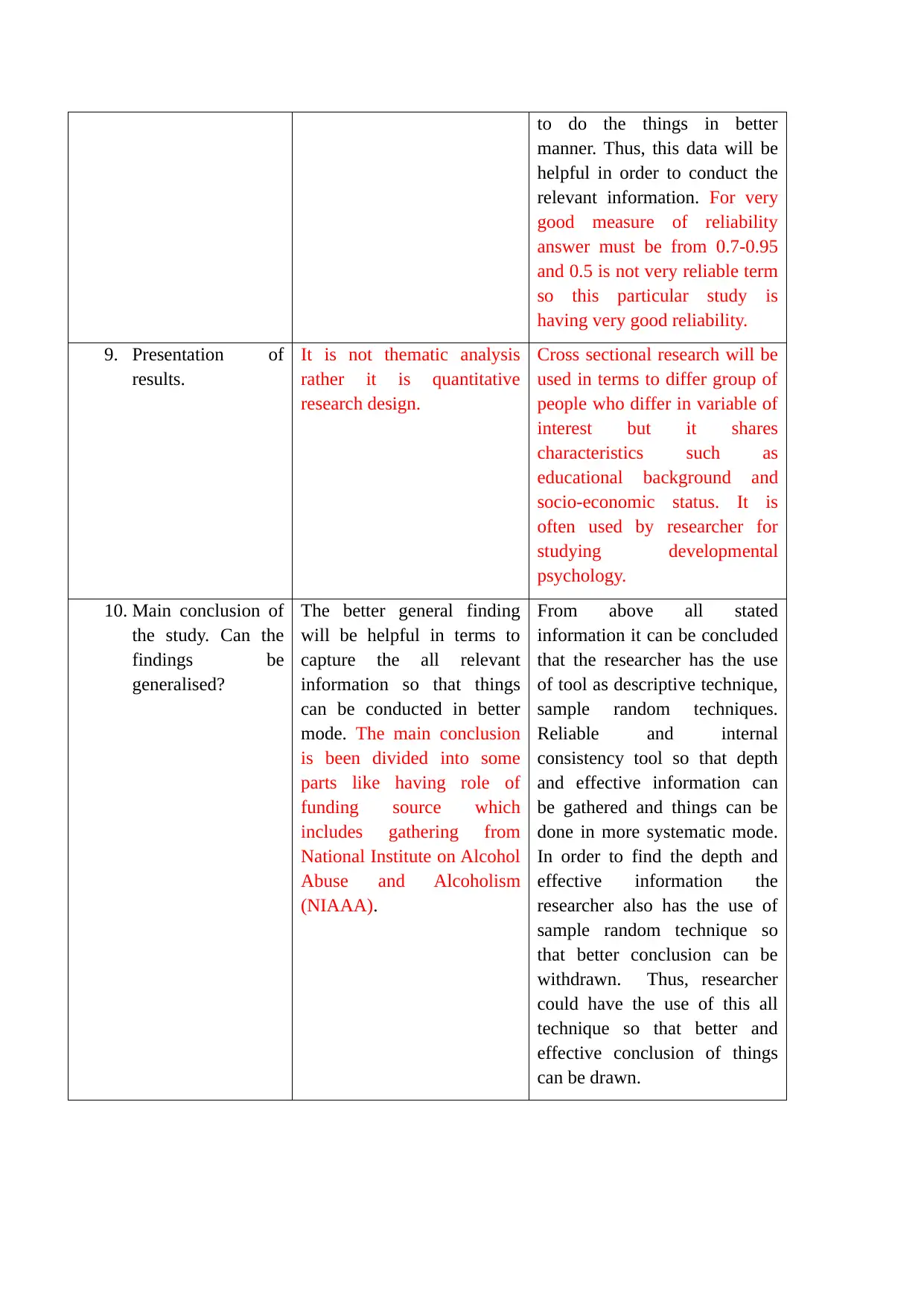
to do the things in better
manner. Thus, this data will be
helpful in order to conduct the
relevant information. For very
good measure of reliability
answer must be from 0.7-0.95
and 0.5 is not very reliable term
so this particular study is
having very good reliability.
9. Presentation of
results.
It is not thematic analysis
rather it is quantitative
research design.
Cross sectional research will be
used in terms to differ group of
people who differ in variable of
interest but it shares
characteristics such as
educational background and
socio-economic status. It is
often used by researcher for
studying developmental
psychology.
10. Main conclusion of
the study. Can the
findings be
generalised?
The better general finding
will be helpful in terms to
capture the all relevant
information so that things
can be conducted in better
mode. The main conclusion
is been divided into some
parts like having role of
funding source which
includes gathering from
National Institute on Alcohol
Abuse and Alcoholism
(NIAAA).
From above all stated
information it can be concluded
that the researcher has the use
of tool as descriptive technique,
sample random techniques.
Reliable and internal
consistency tool so that depth
and effective information can
be gathered and things can be
done in more systematic mode.
In order to find the depth and
effective information the
researcher also has the use of
sample random technique so
that better conclusion can be
withdrawn. Thus, researcher
could have the use of this all
technique so that better and
effective conclusion of things
can be drawn.
manner. Thus, this data will be
helpful in order to conduct the
relevant information. For very
good measure of reliability
answer must be from 0.7-0.95
and 0.5 is not very reliable term
so this particular study is
having very good reliability.
9. Presentation of
results.
It is not thematic analysis
rather it is quantitative
research design.
Cross sectional research will be
used in terms to differ group of
people who differ in variable of
interest but it shares
characteristics such as
educational background and
socio-economic status. It is
often used by researcher for
studying developmental
psychology.
10. Main conclusion of
the study. Can the
findings be
generalised?
The better general finding
will be helpful in terms to
capture the all relevant
information so that things
can be conducted in better
mode. The main conclusion
is been divided into some
parts like having role of
funding source which
includes gathering from
National Institute on Alcohol
Abuse and Alcoholism
(NIAAA).
From above all stated
information it can be concluded
that the researcher has the use
of tool as descriptive technique,
sample random techniques.
Reliable and internal
consistency tool so that depth
and effective information can
be gathered and things can be
done in more systematic mode.
In order to find the depth and
effective information the
researcher also has the use of
sample random technique so
that better conclusion can be
withdrawn. Thus, researcher
could have the use of this all
technique so that better and
effective conclusion of things
can be drawn.
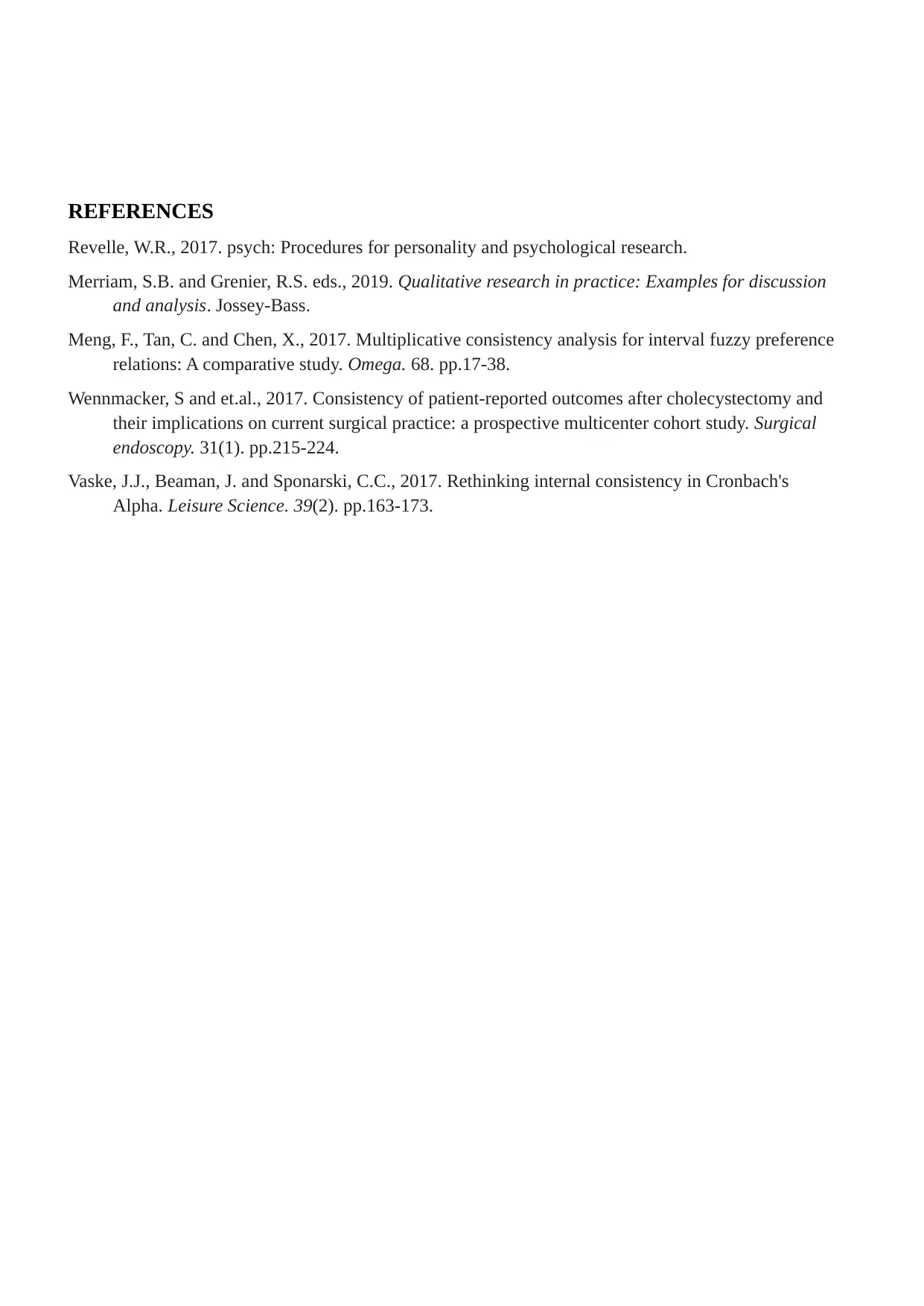
REFERENCES
Revelle, W.R., 2017. psych: Procedures for personality and psychological research.
Merriam, S.B. and Grenier, R.S. eds., 2019. Qualitative research in practice: Examples for discussion
and analysis. Jossey-Bass.
Meng, F., Tan, C. and Chen, X., 2017. Multiplicative consistency analysis for interval fuzzy preference
relations: A comparative study. Omega. 68. pp.17-38.
Wennmacker, S and et.al., 2017. Consistency of patient-reported outcomes after cholecystectomy and
their implications on current surgical practice: a prospective multicenter cohort study. Surgical
endoscopy. 31(1). pp.215-224.
Vaske, J.J., Beaman, J. and Sponarski, C.C., 2017. Rethinking internal consistency in Cronbach's
Alpha. Leisure Science. 39(2). pp.163-173.
Revelle, W.R., 2017. psych: Procedures for personality and psychological research.
Merriam, S.B. and Grenier, R.S. eds., 2019. Qualitative research in practice: Examples for discussion
and analysis. Jossey-Bass.
Meng, F., Tan, C. and Chen, X., 2017. Multiplicative consistency analysis for interval fuzzy preference
relations: A comparative study. Omega. 68. pp.17-38.
Wennmacker, S and et.al., 2017. Consistency of patient-reported outcomes after cholecystectomy and
their implications on current surgical practice: a prospective multicenter cohort study. Surgical
endoscopy. 31(1). pp.215-224.
Vaske, J.J., Beaman, J. and Sponarski, C.C., 2017. Rethinking internal consistency in Cronbach's
Alpha. Leisure Science. 39(2). pp.163-173.
⊘ This is a preview!⊘
Do you want full access?
Subscribe today to unlock all pages.

Trusted by 1+ million students worldwide
1 out of 6
Related Documents
Your All-in-One AI-Powered Toolkit for Academic Success.
+13062052269
info@desklib.com
Available 24*7 on WhatsApp / Email
![[object Object]](/_next/static/media/star-bottom.7253800d.svg)
Unlock your academic potential
Copyright © 2020–2025 A2Z Services. All Rights Reserved. Developed and managed by ZUCOL.





